The recent record rainfall and flooding in south-eastern Queensland (2010) has had a huge impact on many people, with towns everywhere still surrounded by floodwaters.
Although our backyard in Toowoomba has thankfully not gone underwater, its dust-bowl appearance has been replaced with a more Tropical theme — the place is a steaming jungle of vines, weeds and tall grass, the hum of cicadas at dusk broken by the calls of howler monkeys, the fog pierced only by the glimmer of the neighbour’s Christmas lights.
Butterflies and dragonflies are cruising through the backyard, as the heat and sunshine powers an explosion in invertebrate life. Some wandering invertebrates have, to some people, been quite unwelcome.
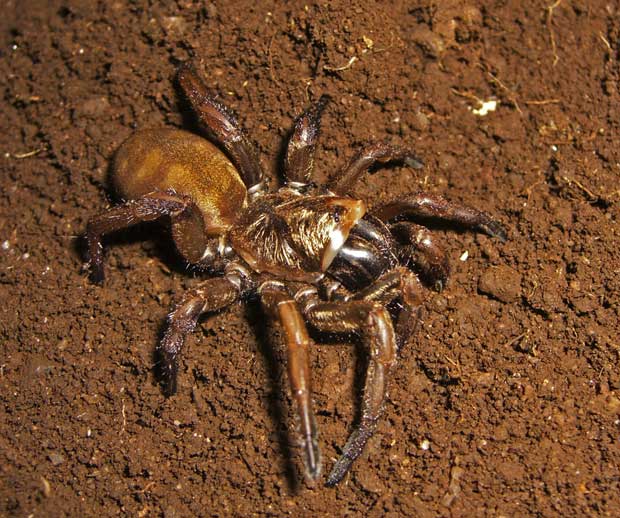
A female Tube Trapdoor Spider, dug out of a burrow in our backyard several years ago by my inquisitive son. A beautiful spider, with golden hairs on the carapace that distinguish this species from those of the true trapdoor group. Photo R. Ashdown.
My son first discovered Tube Trapdoor Spiders living in our backyard a few years back after digging up one of their burrows. We’ve noticed their burrows again in the backyard after the rain – perhaps their burrows are waterlogged and they have to move.
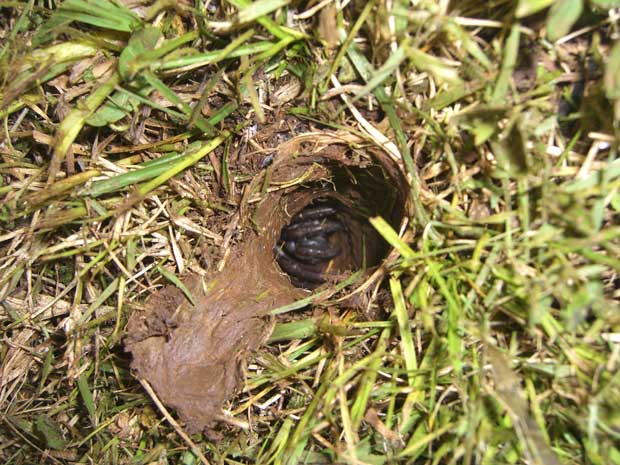
A Tube Trapdoor spider in a very muddy and water-logged burrow in our front yard after recent rain. The silk-lined burrow, which is built with an open entrance, may be lined with dead leaves and can even extend above the ground. Photo R. Ashdown.
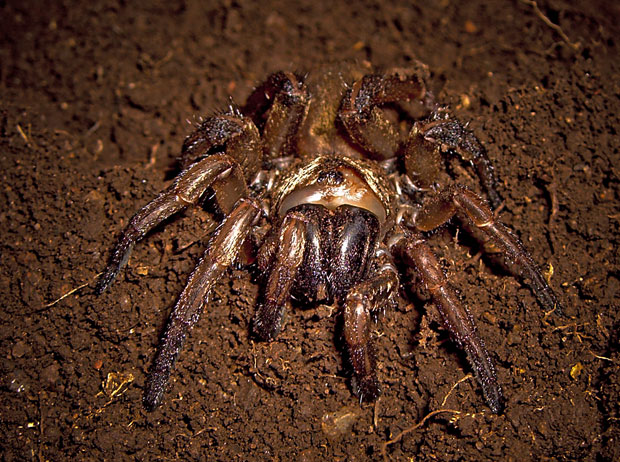
Another view of this striking animal. There are several species of brown tube spiders, found throughout coastal eastern Australia from Tasmania and South Australia to Cape Tribulation. Photo R. Ashdown.
Robert Raven from the Queensland Museum believes that the Toowoomba tube trapdoor found in our yard is a member of the genus Misgolas. Identifying spiders to the species level is no easy task, as spider taxonomy is constantly being revised, with new species discovered and existing relationships reviewed.
Although they may look a bit fierce, no bites have been recorded from these spiders and they are not considered dangerous.
Another spider that Toowoomba residents encounter in summer after rain is definitely dangerous — the Toowoomba Funnelweb (Hadronyche infensa). We haven’t seen any of these spiders in our backyard, but they are found around the eastern edges of the city’s escarpment. This is actually the most common of the four Funnelweb species in Queensland.
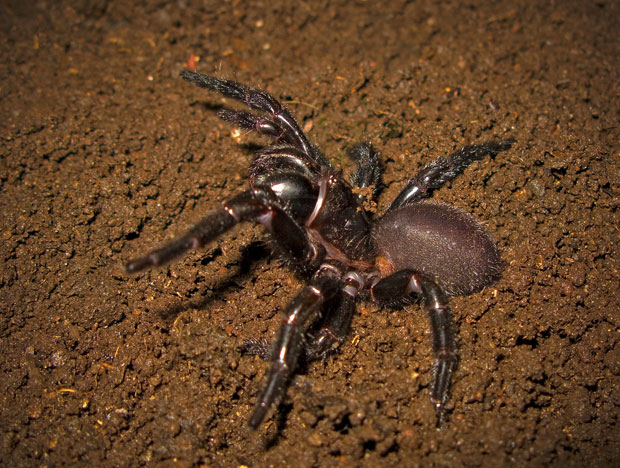
Our very own Funnelweb. Named after my hometown, the Toowoomba Funnelweb (Hadronyche infensa) is one of four species of Funnelweb found in Queensland. The Northern Rivers Funnelweb (Hadronyche formidabilis) builds its burrow on trees. Photo R. Ashdown.
Funnelwebs hunt and mate at night. With rain and heat, male Funnelwebs shed their skins inside their burrows and wander in search of females. This is when they may take a wrong turn and end up in houses. At dawn they seek shelter under logs and amongst clumps of leaves — where they are sometimes encountered by gardeners.
A recent newspaper article quotes Mary Rayner, the General Manager of the Australian Reptile Park on the New South Wales central coast. Ms Rayner said that members of the public had dropped off higher numbers of Funnelweb Spiders this summer. “We usually catch about 300 a year, but we’ve had 100 so far and that is very unusual for this time of year.”
Funnelwebs are one of the world’s most dangerous spiders, with 14 deaths attributed to bites before an antivenom was developed in 1981. All deaths were from male spiders and were in New South Wales. While their venom is deadly to humans, it is harmless to dogs and cats. There are still occasional bites to people in Queensland, with a recent case from Newmarket in Brisbane.
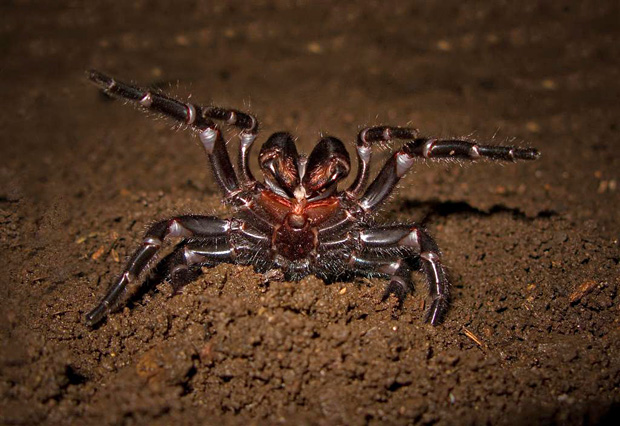
Don’t try this at home – I photographed this Tooowoomba Funnelweb with care. The Queensland Museum reports that “Often, with very little provocation, Funnelwebs will rise into the defensive pose with a drop of highly toxic venom hanging off each fang.” Apparently one drop is enough to kill an adult human, although much of the venom is often absorbed in clothes during bites. They certainly have a lot of character! Photo R. Ashdown.
Identification of large, dark spiders is very difficult, as the features of the animal have to be carefully examined — not recommended unless you are a spider expert. Unfortunately, many large, harmless spiders are killed in the mistaken belief that they are Funnelwebs.
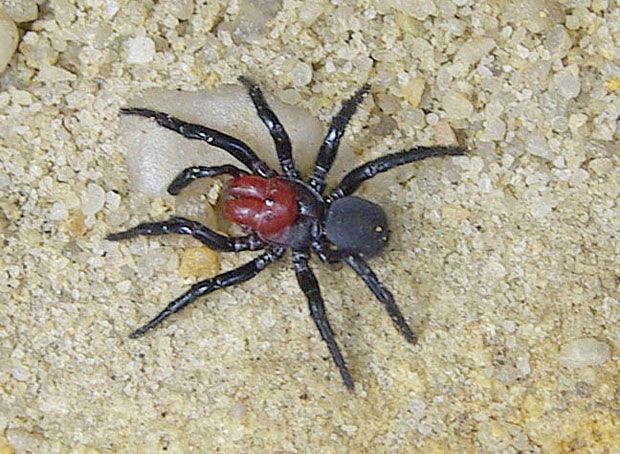
Not every black spider is a Funnelweb. This Red-headed Mouse Spider (Missulena occcatoria) was photographed at Isla Gorge National Park. Found across semi-arid Australia, the patterns of this colourful spider may act both as a warning and disruptive colouration, deterring some predators while allowing the animal to blend into the sharply shadowed background. Photo R. Ashdown and R. Mancini.
While preparing this blog posting, and thinking about spiders, I encountered a large black spider wandering across the Toowoomba bush path on which I was walking. Unfortunately I had nothing to capture it in (pockets not really an option), so I had to resort to a few photos from my dodgy mobile phone. Naturalist mate Rod Hobson has taken a look at the photos and, given that these critters extremely difficult to identify from photographs, reckons it is probably a female Funnelweb, although he cannot say whether it is a Toowoomba Funnelweb or a Northern Rivers Funnelweb.
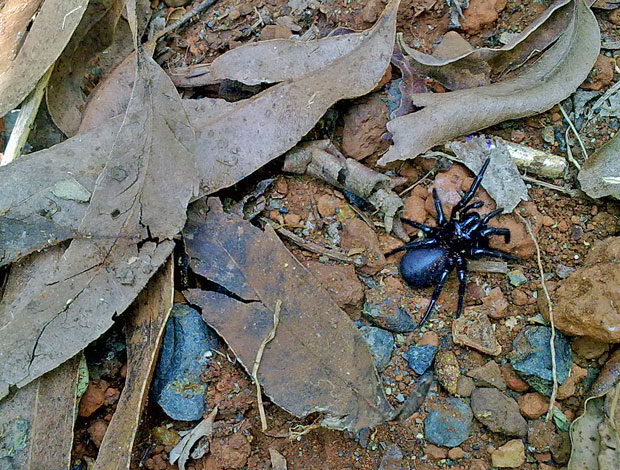
Out for a New Year’s stroll. While walking a track at Mt Lofty, Toowoomba, I bump into a fellow wandering local — a possible female Funnelweb. I say possible because these spiders are hard to identify without a close examination, and a grumpy, warmed-up spider is best admired from a distance. Not a great idea to have one of these attached to your finger on a Public Holiday. Photo R. Ashdown.
There are all sorts of urban myths about spiders, particularly Funnelwebs. For a wealth of accurate information about this, and many other, species of spider head to the excellent information pages on the Queensland Museum’s website.
LINKS
